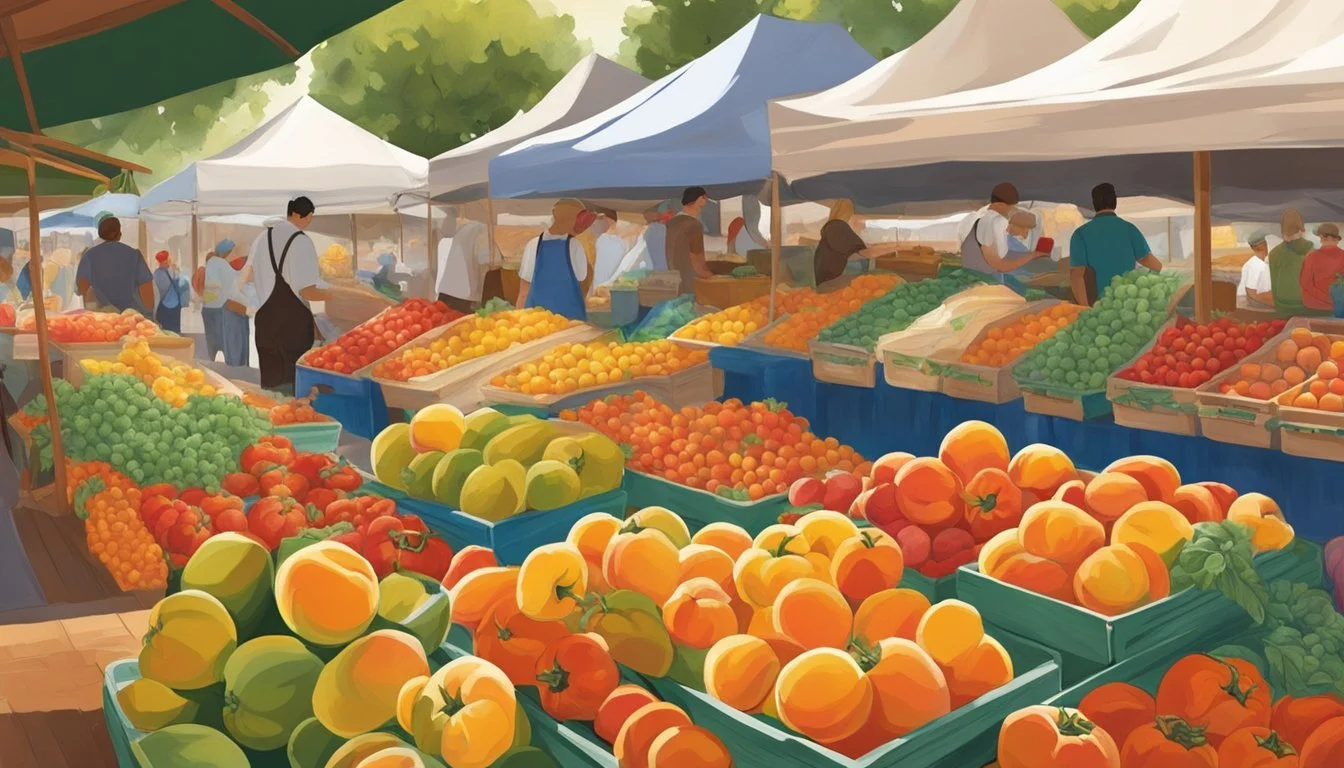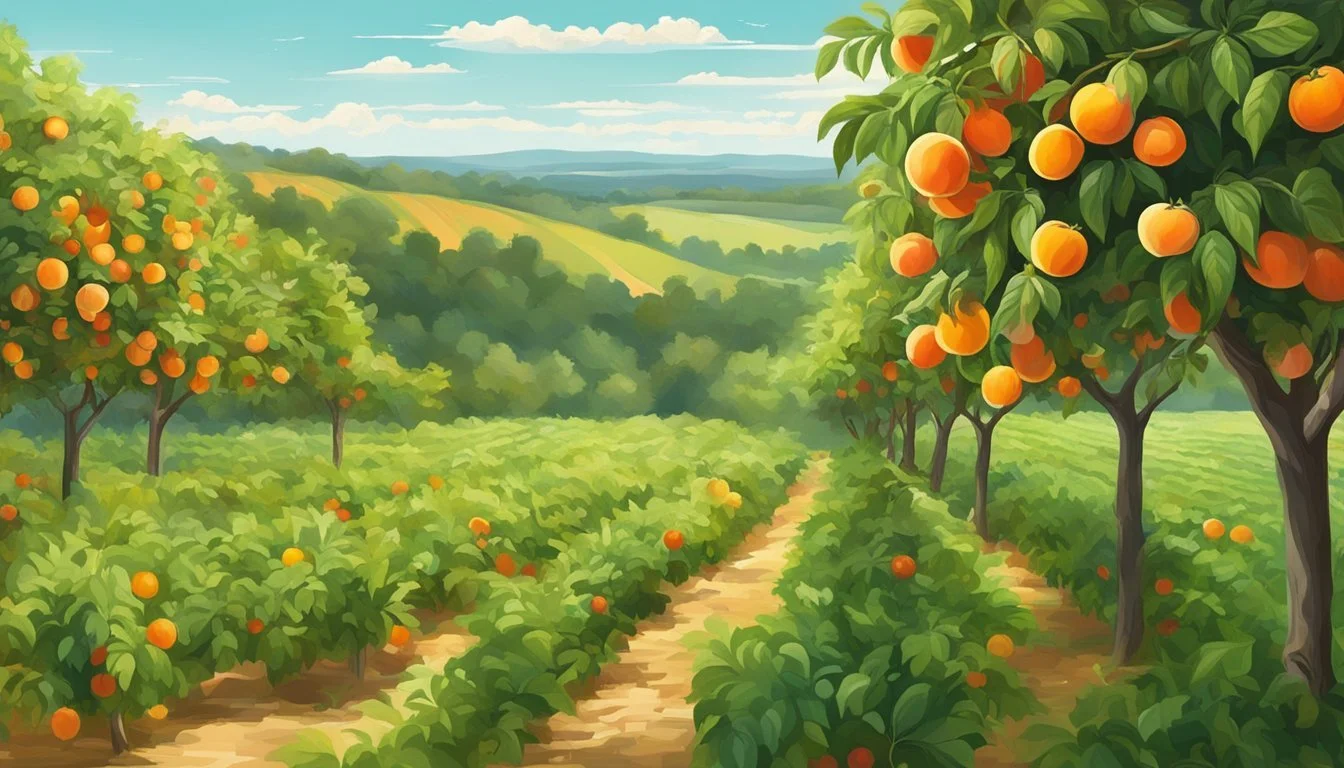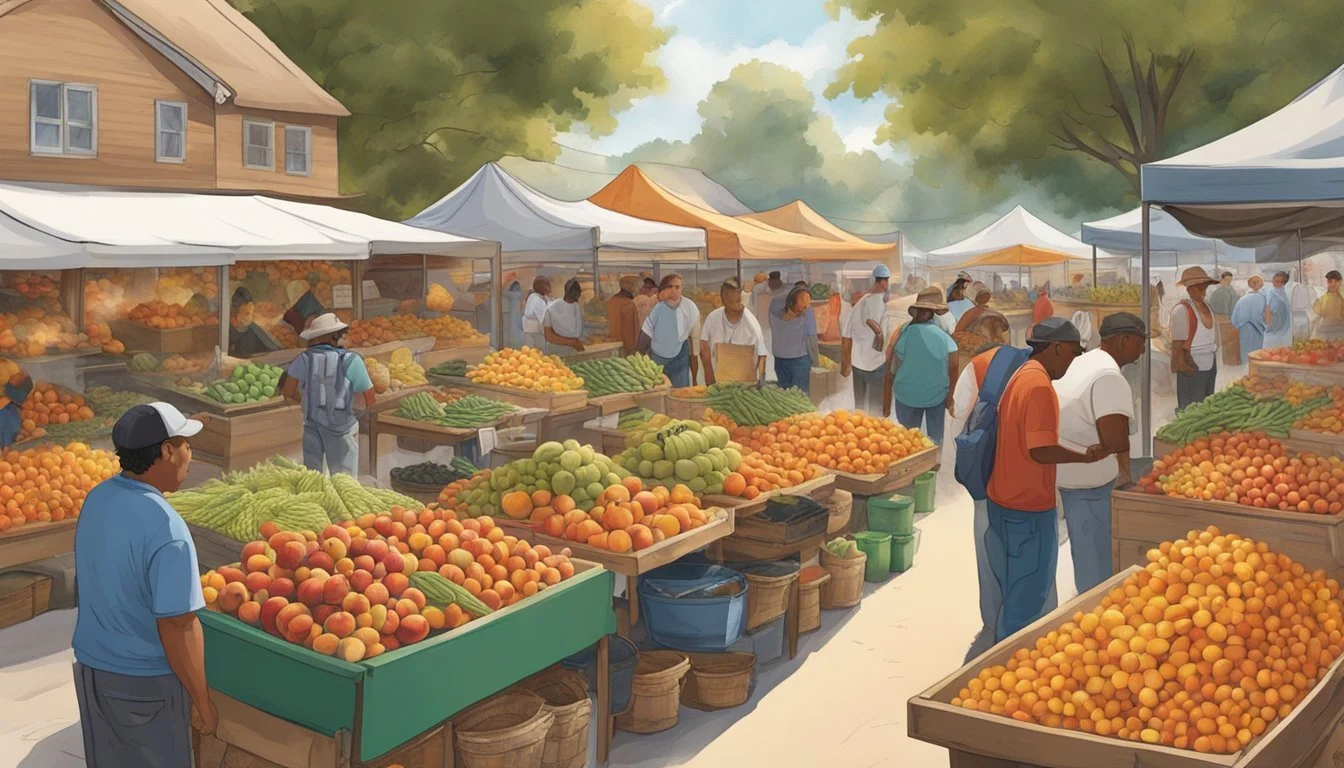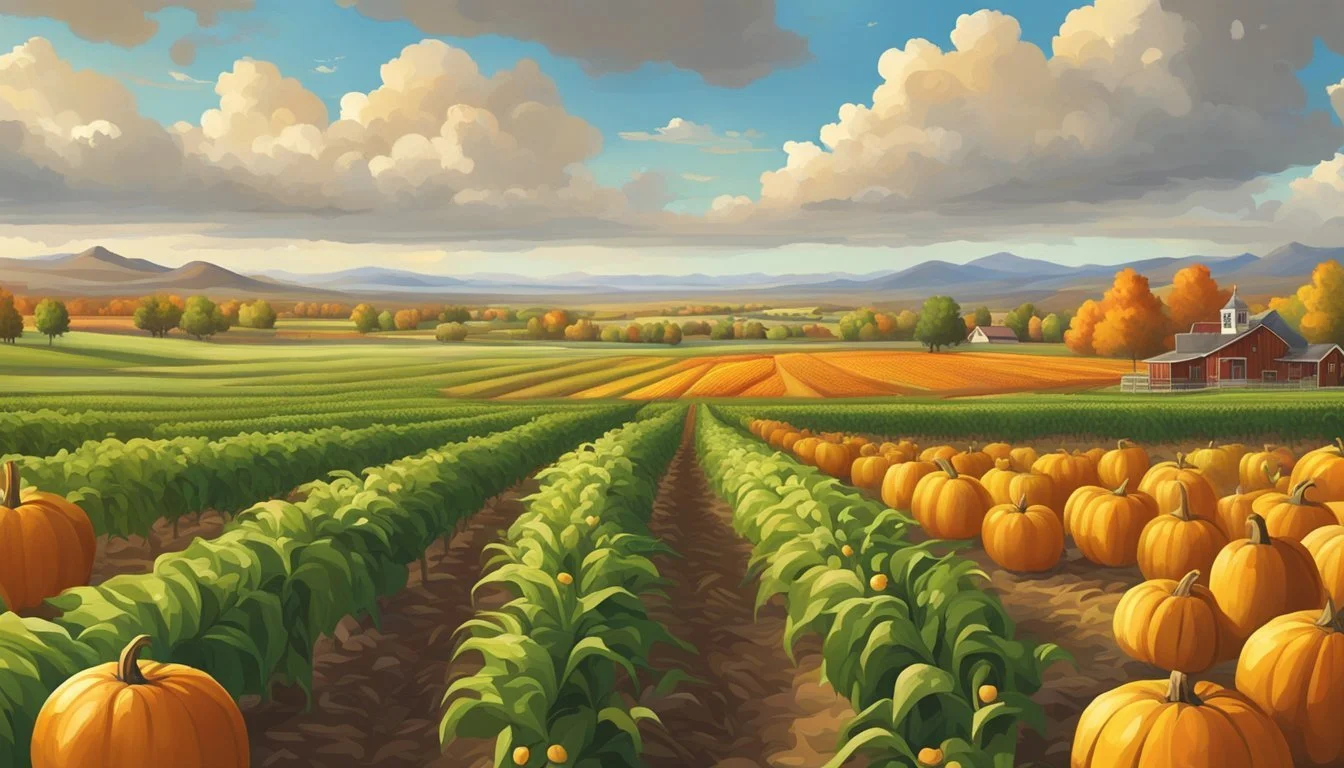Colorado Seasonal Fruit & Vegetables in September
Your Guide to Autumn Harvest
This Article is Part of our Colorado Seasonal Fruit & Veg Calendar
September signals the bountiful harvest season in Colorado, making it an exciting time for both local residents and culinary enthusiasts. The state's diverse climate and geography allow for a variety of fruits and vegetables to thrive. As summer begins to transition into fall, the warmer days give way to cooler nights, creating ideal conditions for a rich assortment of produce. Among the notable offerings, one can expect to find apples (how long do apples last?), a hallmark of the season, which come to ripeness delivering crisp, juicy flavors to the palate.
In addition to apples, September is a prime month for harvesting other fruits such as plums, peaches, and pears, each bursting with natural sweetness and perfect for a range of dishes from fresh salads to hearty pies. Vegetables are also at their peak during this time, providing an array of colors, textures, and flavors for the dinner table. Root vegetables like beets and carrots, along with various types of squash, including butternut and spaghetti, are ready for picking, offering a versatility that chefs and home cooks alike heavily seek after.
The September harvest is not just about the variety of produce but also about the quality and freshness that comes with locally grown fruits and vegetables. The support of local agriculture is evidenced through community markets and farm-to-table restaurants, where the short time from harvest to consumption ensures the utmost flavor and nutrition. This focus on local produce is not only beneficial for the Colorado economy but also encourages sustainable farming practices and provides a uniquely fresh dining experience that can only be found during this fruitful season.
Overview of Colorado's Growing Season
Colorado boasts a robust and diverse agricultural landscape, lending itself to a wide array of produce throughout its growing season. The state's unique geography, with varying elevations and climates, plays a significant role in determining what and when crops can be planted and harvested.
Spring marks the beginning of the growing season in Colorado, when early produce such as leafy greens begin to appear. As the season progresses towards summer, the selection expands considerably. Farmers' markets brim with an assortment of fruits and vegetables, from juicy heirloom tomatoes to sweet corn and crunchy cucumbers.
When September arrives, Colorado's growing season is at its peak. The cooler temperatures are ideal for a second planting of certain crops, extending availability well into the fall. Below is a list of typical crops harvested in September in Colorado:
Vegetables: carrots, beets, leafy greens, and squash
Fruits: apples, pears, and peaches
Each crop's availability may vary slightly from year to year, influenced by factors such as weather conditions and specific regional microclimates.
Farmers carefully plan their crop rotations and planting schedules to maximize yield and ensure a continuous supply of fresh produce. They utilize greenhouses and other controlled environments to extend the growing capabilities for certain items.
Colorado's produce is celebrated for its freshness and quality, the result of the attentive care given during its growing season. Consumers are encouraged to partake in the bountiful harvest by shopping at local markets or joining community-supported agriculture (CSA) programs.
Seasonal Shifts and Their Impact on Produce
In Colorado, the month of September is a time of transition where the bounties of summer begin to give way to the harvests of fall, influencing both availability and variety of local produce.
Transitioning from Summer to Fall
September in Colorado marks the gradual shift from the long, warm days of summer to the cooler evenings of fall. This change signals plants to move into new phases of growth, some maturing their fruit while others begin to enter a dormant period. Stone fruits like peaches wrap up their season, while apples and pears become more prominent.
Summer Crops Phasing Out:
Tomatoes
Zucchini
Peaches
Fall Crops Coming into Season:
Apples
Pears
Squash
September's Agricultural Significance
This ninth month is significant in the agricultural calendar as it represents a critical time for both harvesting and preparing for the approaching colder months. Farmers work to gather the last of the summer produce before the first frosts of October, and they start to harvest fall crops that are coming into their prime.
Key Harvests in September:
Root Vegetables:
Carrots
Beets
Fruits:
Apples
Pears
The emphasis during September is on ensuring a seamless transition to safeguard the livelihood of farmers and the continuity of fresh produce for consumers into November and beyond.
Fruit Harvests in September
In September, Colorado's orchards and farms offer a bounty of tree fruits, a diverse variety of berries, and a selection of ripe melons.
Tree Fruit Varieties
Colorado produces several tree fruits that reach peak ripeness in September. One can expect:
Apples: A staple of the fall harvest with varieties like Honeycrisp, Gala, and McIntosh available.
Peaches: The late-season varieties are picked during this month, offering juicy and flavor-rich fruit.
Pears: Bartlett and D'Anjou pears are typically ready for harvest.
Plums: They often reach their peak in early September, offering sweet and tart flavors.
Nectarines: Closely related to peaches, nectarines have a smooth skin and are usually ready at the same time.
Berry Harvests
Berry season continues into September with:
Raspberries: They have a second harvest season that can extend into this month, providing fresh and tart berries.
Melon Availability
Melons found in the region may include:
Cantaloupes (how long does cantaloupe last?) and honeydew melons: These melons are generally available and are best enjoyed for their sweet and refreshing taste.
Throughout the month, these fruits are typically at their best quality and flavor, and one can find them at local markets, farm stands, or by visiting the orchards and farms directly for a harvest experience.
September's Vegetable Bounty
September in Colorado sees a rich harvest of vegetables, offering a medley from the earth's underground pantry to a variety of leafy crowns and hearty squashes. These crops represent the peak of their freshness and nutritional value, making this month particularly abundant for local produce.
Root Vegetables and Tubers
Colorado's fertile soil yields an impressive selection of root vegetables and tubers in September. Potatoes come in varieties from russets to fingerlings, while carrots offer their crisp sweetness. Beets and radishes contribute a burst of color and a peppery zing to dishes. Turnips and onions are also robust during this period, each adding their distinctive flavors to the fall palette.
Potatoes: Russets, reds, and golds
Carrots: Orange and purple varieties
Beets: Red and golden
Radishes: Cherry belle and French breakfast
Turnips: White and purple-topped
Onions: Yellow, red, and white
Leafy Greens and Cruciferous Vegetables
The cool nights of Colorado at this time of year are ideal for cultivating leafy greens. Kale, (What wine goes well with kale?) with its rich, earthy tones and hearty texture, stands out alongside tender spinach and various types of lettuce. In addition, this month is significant for the growth of cruciferous vegetables, such as broccoli and cauliflower, which demand attention on the dinner plate with their dense nutrient profiles.
Kale: Curly and lacinato (dinosaur) varieties
Spinach: Smooth and savoy types
Lettuce: Romaine, butterhead, and leafy varieties
Broccoli: Calabrese and sprouting types
Cauliflower: White and colored (such as purple and orange) variants
Squash and Gourds
A true sign of the coming fall is the arrival of squash and gourds. Winter squash varieties start to come into their prime, including butternut, acorn, and spaghetti squash. Not to be outshone, zucchini and summer squash still linger from the summer's warmth. Pumpkins also begin to make their appearance, hinting at the festive season ahead.
Winter Squash: Butternut, acorn, spaghetti, and delicata
Summer Squash: Zucchini and yellow squash
Pumpkins: Pie and carving varieties
From root to leaf, September is truly a month where Colorado's soil demonstrates its productive prowess, bringing forth vegetables that provide a canvas of flavors and textures for culinary exploration.
Local Markets and Farm Stands
In Colorado, September ushers in a plethora of local markets and farm stands that showcase the state's agricultural bounty during the harvest season. Consumers can revel in the vibrant colors and fresh flavors of locally-grown produce, directly connecting them to the state's agricultural roots.
Where to Find Them:
Farmers' Markets: These are hubs for fresh, seasonal produce and often feature a variety of vendors. They provide an opportunity to meet the growers and learn more about where and how the food was cultivated.
Roadside Stands: Scattered across rural and suburban roadways, these stands offer a quick stop to grab fresh fruits and vegetables often picked that very morning.
What They Offer:
Fruits: Expect to find an array of stone fruits such as peaches and plums, alongside fall favorites like apples and pears.
Vegetables: Squashes and root vegetables will be in abundance, along with greens like kale and chard that thrive in the cooler temperatures of early fall.
Type Examples Farmers' Markets Boulder Farmers Market Roadside Stands Smith's Farm Fresh Produce
Colorado's farm stands and local markets are integral to sustaining local agriculture, allowing farmers to sell their goods directly to the public—thus ensuring the freshest produce possible for consumers. It's an immersive experience that supports the economy and reduces the ecological footprint associated with long-distance food transportation. September is the perfect month to explore these local treasures and enjoy Colorado's seasonal harvest.
Preparing and Cooking Regional Produce
In September, Colorado's harvest provides a bounty of fresh produce ideal for both raw consumption and a variety of cooked dishes. The following information serves as a guide to making the most out of the seasonal fruits and vegetables.
Raw and Salad Options
Arugula is a peppery green that thrives in Colorado's September climate. It serves as the perfect base for a salad or can be incorporated as a fresh element in sandwiches and wraps. Combining arugula with slices of sweet, ripe pears, which are also in season, can offer a delightful balance of flavors and textures.
For a nutritious crunch, sprouts are a versatile choice. They can be easily grown at home from seeds, such as beans or alfalfa, and tossed into salads or used as a garnish for added texture and nutrients.
Cooked Dish Inspirations
When it comes to cooking, Colorado's seasonal produce shines in a variety of warm dishes. Soups and stews benefit from the earthy sweetness of regional vegetables like pumpkins and squashes, which can be roasted to enhance their flavor before being blended into hearty autumn soups.
Roasting or grilling brings out the natural sugars in vegetables, making them ideal for integrating into cooked dishes. Bell peppers, eggplants, and fennel (how long does fennel last?) are among the vegetables that respond well to these cooking methods, offering a rich, caramelized profile suitable for adding depth to any dish.
Farming Practices in Colorado
Colorado's agriculture is distinct because of its unique geographical and climatic conditions. Farmers across the state have to adapt their practices to work with varying altitudes, semi-arid climates, and the diverse topography that defines the region.
Irrigation is a critical practice due to the state's low rainfall. Water is often sourced from the Colorado River and distributed through a network of ditches and canals, enabling the cultivation of various crops during the growing season, which includes September.
Soil management is also tailored to local conditions, with amendments such as compost and fertilizers being essential to boost the nutrient-poor native soils. Crop rotation and cover cropping are common practices to maintain soil health and manage pests and diseases sustainably.
Here's a snapshot of Colorado's farming techniques:
Water Conservation: Drip and sprinkler irrigation systems
Soil Health: Use of organic matter; crop rotations
Pest Management: Integrated pest management techniques
Climate Adaptation: Selection of crop varieties resilient to weather extremes
High-altitude farming presents both a challenge and an advantage. Some farmers opt for crops that benefit from cooler temperatures and reduced pest pressure at higher elevations. Others who farm at lower elevations choose warm-season crops that thrive in the heat.
In September, Colorado farmers are often in the midst of harvest, reaping the benefits of their labor with crops that include but are not limited to corn, pumpkins, and late-season peaches. Precision and conservation are at the heart of Colorado's farming practices, ensuring that agriculture remains sustainable and productive.
Nutritional Benefits of Seasonal Eating
Engaging in seasonal eating, particularly in September in Colorado, offers a robust array of nutritional advantages. Seasonal fruits and vegetables harvested at their peak ripeness tend to have the highest nutritional value. For example, fresh, sweet corn harvested in the late summer is rich in fiber, antioxidants, and B vitamins.
Eating raw, seasonal vegetables like salads can maximize the intake of essential vitamins and minerals. A serving of raw spinach or kale from a local Colorado farm brings forth an impressive quantity of Vitamin K, essential for bone health.
Here's a brief overview of the typical seasonal produce during September in Colorado and their nutritional highlights:
Tomatoes: High in lycopene when ripe and vitamin C.
Spinach: An excellent source of iron and magnesium.
Green Beans: Contain fiber, vitamin K, and silicon (needed for healthy bones, skin, and hair).
Peppers: Rich in vitamins A and C, and can be sweeter as they ripen.
Peaches: Supplying vitamins A and C along with dietary fiber, especially when enjoyed fresh.
They should consider the nutritional synergy of combining these seasonal produce items to create a wholesome meal. For instance, combining a leafy green like spinach with a vitamin C-rich fruit like peaches can enhance iron absorption.
Incorporating these seasonal fruits and vegetables into one's diet could also support local agriculture and reduce the environmental impact associated with long-distance food transportation.
Tips for Selecting and Storing Produce
When selecting fruits like apples, which peak in the fall in Colorado, one should look for firmness and unblemished skin as signs of quality. Apples should be stored in a cool, dark place, and if possible, in a perforated plastic bag in the refrigerator to maintain their crispness.
For vegetables such as pumpkins and chard, the key is to choose specimens that feel heavy for their size and have vibrant, un-wilted leaves. Pumpkins should be stored in a cool, dry place, whereas chard can be kept in the refrigerator, ideally in the crisper drawer to preserve its moisture.
Colorado's produce varieties in September:
Apples: Sweet and crunchy, store in a cool location.
Chard: Nutrient rich, keep refrigerated in a loose plastic bag.
Kale: For maximum flavor, eat raw or lightly cooked; refrigerate.
Squash: Varieties of squash should feel firm; store in a cool, dry place.
When enjoying produce raw, ensure it is thoroughly washed under running water to remove any dirt or residues. For juicier flavors, fruits are often best eaten at room temperature, while a slight chill can enhance the sensation of crisp vegetables.
In summary, proper selection and storage methods not only extend the shelf life of Colorado's seasonal produce but also help maintain their nutritional value and flavor. One should always remember to handle produce with care to prevent bruising, and to ensure that any cut fruits (how long do cut fruits last?) or vegetables are refrigerated promptly.
Encouraging Sustainable Consumption
In Colorado, the agricultural landscape in September offers an abundance of produce. Consumers have a pivotal role in fostering sustainability through their choices. By selecting local and seasonal fruits and vegetables, they minimize the environmental impact often associated with long-distance transportation.
Local Harvests Benefits:
Reduced Carbon Footprint: Local produce requires less transportation, resulting in lower greenhouse gas emissions.
Supporting Local Economy: Purchasing from Colorado farms bolsters the local economy and sustains agricultural jobs.
Fresher Produce: Locally harvested fruits and vegetables are often fresher, having been picked at their peak ripeness.
Engaging with Colorado's agricultural output by frequenting farmers' markets or joining community-supported agriculture (CSA) programs can make a sizable difference. It encourages the maintenance of diverse, regional crop varieties, which in turn supports biodiversity.
September's Sustainable Picks in Colorado:
Fruits: Apples, Pears
Vegetables: Beets, Carrots, and Squash
Every sustainable choice counts. Consumers can shape demand and influence farming practices by preferring produce that adheres to ethical and environmentally friendly methods. This approach in Colorado not only preserves natural resources but also ensures the longevity of its agricultural heritage.
By focusing on local and seasonal produce, consumers help in creating a more resilient food system. The conscious decision to opt for Colorado's September offerings is a step towards a more sustainable future.












